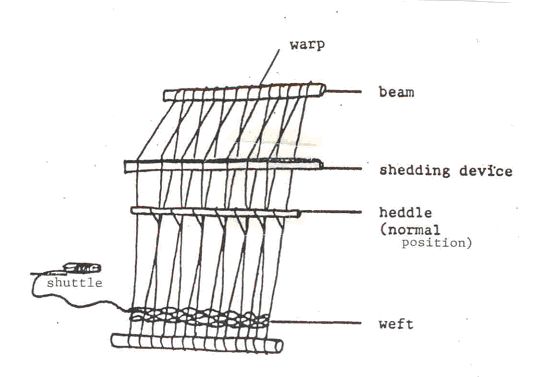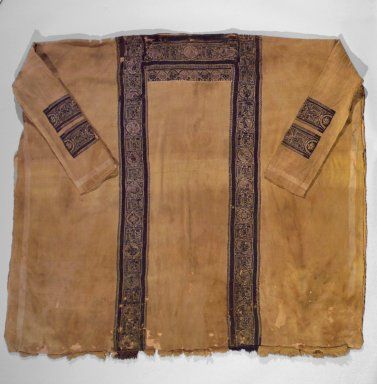THE AGE OF MIGRATIONS
600-1100
After the western Roman Empire collapsed, people started migrating to new areas, sometimes by invasion and conquest, sometimes through peaceful settlement.
In Northern European areas, Germanic, Frankish, and Norse-speaking peoples needed warm, water-repelling clothes in the cold climate, so wool was the main cloth used.
People in warmer Mediterranean regions had lighter clothing in linens, wools, and sometimes silk -- if they could afford it.
Both men and women wore loose tunics, based on rectangles sewn together in different styles, and caught with belts.
Mantles (cloaks) were draped over tunics, sometimes with status-enhancing fur linings.
Men wore trews (the forerunner of pants) below the waist, wrapped with wool bands or leather below the knee.
Linen shirts were worn as undergarments beneath tunics, and sometimes worn on their own in summer.
Surviving clothing from burials reveals a love of finery in embroidery, tablet-woven braids, and intricate jewelry.
TEXTILE PRODUCTION
Before the horizontal loom's introduction, c.1000, all European weaving was done on vertical looms.
Producing cloth was extremely labor intensive and women did most of it at home.
Wool, the most common fiber, had to be shorn, cleaned, and carded (brushed), then spun with a drop-spindle.
The loom was set up with vertical warp threads, and finally the weft threads were woven horizontally over and under the warp to make cloth.
Clothing was based mostly on straight lines, connecting the selvedges (fabric edges) to minimize waste.
JEWELRY
Jewelry was a means of adornment and also a from of portable wealth, easily carried and used as payment.
People living around the Baltic Sea collected amber, the fossilized resin of prehistoric trees, and traded it across Europe and beyond.
Precious metals, such as gold, and jewels had a nearly sacred attribution due to their rarity.
Other metals used included bronze, iron, copper, and tin.
Glass beads appear in many Norse graves.
Men and women held clothing together with ornate round pins and brooches, and wore shapely belt buckles, rings, and earrings.
移民时代
公元600年-1100年
西罗马帝国崩塌后,人们开始朝新地区迁移,有时通过入侵征服,有时通过和平协议。
在欧洲北部地区,讲日耳曼语,法兰克语以及北欧语的人需要保暖,防水的服装抵御寒冷气候,所以羊毛成为了主要面料。
地中海温暖地区的人们穿着更轻的亚麻,羊毛甚至丝绸服装 - 如果他们可以负担的话。
男性与女性都穿着宽松袍子,基于不同风格缝合在一起的凉快矩形,以腰带固定。
Mantles披风(斗篷)披挂在袍子外面,有时会加上显示身份的毛皮里衬。
男性腰部以下穿着trews紧身格子呢绒裤(裤子的前身),膝盖下以羊毛或皮革条捆绑。
亚麻衬衫以内衣方式穿着在袍子里面,夏天也能单独穿着。
葬墓遗留物上显示出当时人们对华丽刺绣,平纹编织辫以及繁复首饰的喜爱。
纺织生产
公元1000年,在水平织布机问世之前,整个欧洲都在垂直织布机上编织的。
织布是极其密集型的劳动,妇女要花大部分的时间在家工作。
羊毛,是最常见的纤维,它需要修剪,清洁以及梳理,然后将它们揉搓旋转成纺丝。
垂直织布机上会先排列好垂直经线,之后利用纬线穿线器上下水平地在经纱上进行编织,从而制成布料。
服装基本依照直线裁剪,以减少浪费。
珠宝首饰
珠宝史装饰方式,也是便携财富,方便携带以及支付。
居住在波罗的海周围的人们收集琥珀,一种史前树木留下的树脂化石,并将它售卖到了欧洲本土与之外的地区。
贵金属,例如黄金和宝石,由于极其稀有,他们被冠以近乎神圣的属性。
其他可用的首饰有青铜,铁,铜和锡。
玻璃珠,出现在许多挪威坟墓里。
男性与女性都会搭配华丽的别针或胸针来聚拢服装,同时穿戴皮带扣,戒指与耳环。





